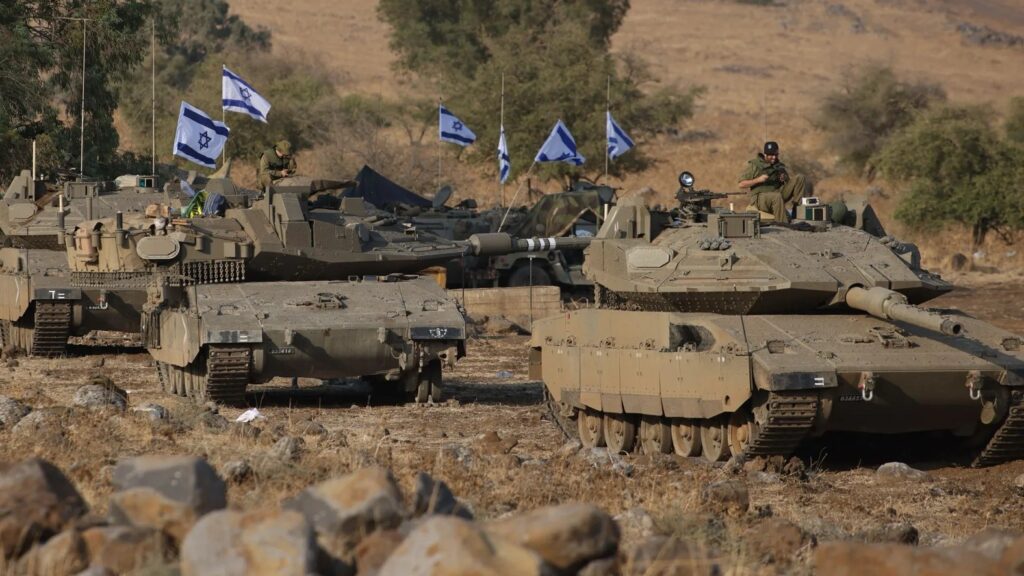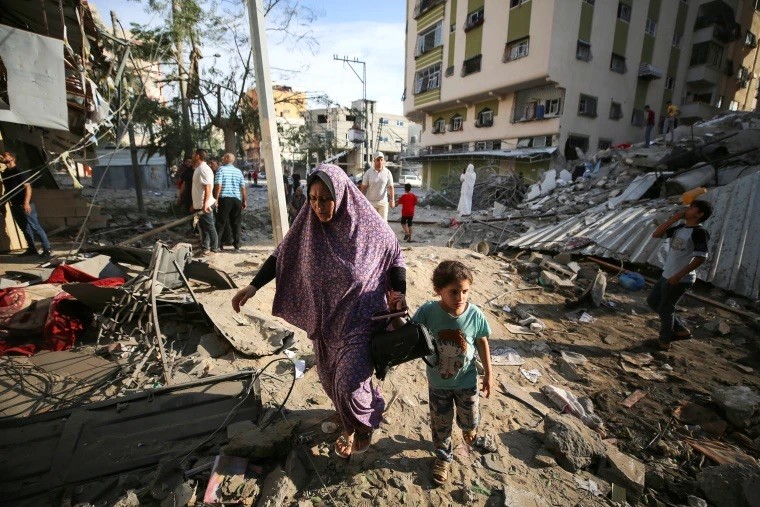The conflict between Israel and Hamas is one of the most protracted and deeply rooted conflicts in the Middle East. Spanning over a century, it has its origins in the late 19th and early 20th centuries when Jews began migrating to Palestine, which was then under Ottoman rule. The Zionist movement, driven by the desire to establish a Jewish homeland, inevitably clashed with the interests of Palestinian Arabs, who vehemently opposed this influx of Jewish immigrants. The seeds of a bitter and complex conflict were sown.
The early roots of the Israeli-Palestinian conflict can be traced to the late 19th century when waves of Jewish immigrants began arriving in Palestine, driven by the ideals of the Zionist movement, which sought to establish a Jewish homeland in the historic land of Israel. Concurrently, the indigenous Arab population of Palestine had deep historical and cultural ties to the region, and many viewed this influx of Jewish immigrants as a direct threat to their land and identity. Tensions simmered as both groups vied for control, creating a volatile atmosphere that would shape the region’s history.
Post-World War II
The aftermath of World War II and the horrors of the Holocaust had a profound impact on the international community’s perspective. In 1947, the United Nations passed a historic resolution to partition Palestine into separate Jewish and Arab states. While the resolution was accepted by Jewish leaders as a path to their long-sought homeland, it was vehemently rejected by Arab leaders who viewed it as a grave injustice, sparking violence and resistance. This decision set the stage for the ensuing decades of conflict in the region.
1948 Arab-Israeli War
The 1948 Arab-Israeli War, also referred to as the War of Independence or Nakba (Catastrophe), was a pivotal moment in the conflict’s history. It led to the establishment of the State of Israel and a significant Palestinian refugee crisis. The war, characterised by territorial disputes and clashes between Arab states and Israel, created a deep-rooted sense of loss and dispossession among Palestinians, which remains a driving force behind the Palestinian struggle for statehood and self-determination.
1967 Six-Day War
In 1967, the Six-Day War had a transformative impact on the conflict. Israel’s stunning victory resulted in the occupation of the West Bank, Gaza Strip, and East Jerusalem. These territories became central to the Israeli-Palestinian conflict, as Israel’s control over them intensified the struggle for sovereignty and self-rule among Palestinians. The status of these territories has remained a contentious issue for decades.
Hamas Emerges
In the late 1980s and early 1990s, the First Intifada (Palestinian uprising) brought further complexity to the conflict. During this period, Hamas, an Islamist militant organisation, emerged as a prominent force in the Gaza Strip. While the PLO, led by Yasser Arafat, was recognised by the international community as the legitimate representative of the Palestinian people and engaged in negotiations with Israel, Hamas, with its ideological resistance to the existence of Israel, posed a formidable challenge to the peace process.
Oslo Accords
The Oslo Accords, signed in 1993, marked a significant turning point in the Israeli-Palestinian conflict. These agreements initiated a peace process between Israel and the Palestinian Liberation Organisation (PLO), leading to the establishment of the Palestinian Authority (PA) and limited self-governance in parts of the West Bank and Gaza. The Oslo process offered hope for a peaceful resolution, but it also encountered significant obstacles on the path to a final agreement, leaving crucial issues unresolved.
Second Intifada
The early 2000s witnessed the outbreak of the Second Intifada, characterised by increased violence, including suicide bombings and Israeli military responses. The failure of the peace process and the continued Israeli occupation fuelled this period of heightened tensions and violence. It further complicated efforts to reach a comprehensive and lasting peace agreement in the region.
Hamas Takes Control of Gaza

In 2007, the conflict took another dramatic turn when Hamas, which openly rejects the existence of Israel, seized control of the Gaza Strip after a brief civil conflict with the Palestinian Authority. This division created a unique challenge for peace efforts, as Gaza and the West Bank became politically distinct entities, each governed by different Palestinian factions, Hamas in Gaza and the Palestinian Authority in the West Bank.
Ongoing Conflict and Ceasefires
Throughout the years, the Israeli-Palestinian conflict has experienced numerous cycles of violence, with rocket attacks from Gaza, Israeli military operations, and intermittent ceasefire agreements. International mediators, including the United States and various regional actors, have repeatedly attempted to broker lasting peace agreements. However, the deeply entrenched issues and the absence of a comprehensive resolution continue to be major obstacles to lasting peace.
Blockade of Gaza
Israel’s imposition of a blockade on the Gaza Strip, citing security concerns, had a profound impact on the humanitarian situation in the region. This blockade, which severely restricted the flow of goods and people in and out of Gaza, compounded the challenges faced by the local population, leading to issues related to economic hardship, healthcare, and overall living conditions.
Gaza Wars
In recent years, several major conflicts erupted in Gaza, including Operation Cast Lead (2008-2009), Operation Pillar of Defence (2012), and Operation Protective Edge (2014). These operations resulted in significant casualties, widespread destruction, and amplified international concerns about the humanitarian situation in the region. The impact of these conflicts on civilian populations in Gaza, as well as the diplomatic repercussions on the international stage, have been profound.
Recent Developments
The Israeli-Hamas conflict continued to experience periodic escalations, with May 2021 witnessing another round of hostilities. During this conflict, Hamas fired rockets into Israel, and Israel responded with airstrikes. International efforts led to a ceasefire, though the underlying issues that fuelled the conflict remained unresolved. This recurring pattern of violence and ceasefire highlights the ongoing challenges in finding a sustainable and comprehensive resolution to the Israeli-Palestinian conflict.
The Israel vs. Palestine Conflict in 2023 took a dramatic turn on October 7th when a large-scale offensive and invasion were launched from the Gaza Strip into Israel. This unprecedented conflict, led by the Palestinian militant group Hamas, marked the first direct Israel-Gaza confrontation fought within the boundaries of Israel itself. The situation escalated when the militant group successfully breached the Gaza-Israel Barrier, forcibly entering Israeli settlements and military installations through the Gaza border crossing.
The conflict began with a dawn raid involving vehicle-mounted attacks on Israeli territory and a barrage of rockets fired into Israel. These attacks were not limited to military bases but also targeted Israeli civilian communities near the Gaza border. The intensity of these actions led some observers to describe this conflict as the onset of a third Palestinian Intifada.
The consequences of this offensive were profound. More than 900 Israelis lost their lives as Hamas militants penetrated Israel’s borders and unleashed over three thousand rockets from the Gaza Strip. The situation became so dire that Israeli Prime Minister Benjamin Netanyahu, in a national address, declared that “Israel is at war.” This development signalled a significant escalation in the ongoing Israel-Hamas conflict, with serious implications for regional stability and international efforts to resolve the crisis.

Amid the relentless bombardment of Gaza, now in its fifth day, the situation has taken a dire turn. The Gaza Strip, home to over two million people, has been plunged into darkness as its sole power plant ran out of fuel. Hospital officials in Gaza have issued an international SOS, warning that their generator capacity is rapidly depleting. Meanwhile, in Israel, Prime Minister Benjamin Netanyahu and opposition party leader Benny Gantz have put aside their political differences to agree to form an emergency government. In a joint address to the Israeli people, they emphasised the need for unity in confronting the threat posed by Hamas.
In a surprising turn of events, Hamas released a video showing a captive and two young children being released. Nevertheless, violence continues to escalate. Israeli soldiers and settler violence in the occupied West Bank have resulted in the loss of at least five Palestinian lives. Additionally, the conflict has had a devastating impact on humanitarian workers, with eleven UN Palestinian refugee agency workers and five members of the International Federation of Red Cross and Red Crescent Societies (IFRC) losing their lives since Saturday.
Israel is now amassing troops near the Gaza Strip as it responds to a multifaceted attack by Hamas. The United States, represented by Secretary of State Antony Blinken’s upcoming visit, is discussing a potential humanitarian corridor in collaboration with Egypt, in response to concerns expressed by the United Nations about civilian casualties. Notably, the Hamas offensive targeted civilian sites, including a music festival, further complicating efforts to reach a resolution.
The repercussions of this ongoing conflict extend into the financial sphere, with concerns that the Israeli crisis may impact the oil markets, given the Middle East’s significance in global oil production. As the hostilities continue, the human toll is rising on both sides. At least 1,200 Israelis have been killed and over 2,700 injured, while in Gaza, approximately 950 people have lost their lives, with more than 5,000 injured.
Meanwhile, Palestinians who were expelled from their workplaces in Israel have started arriving in the occupied West Bank, seeking shelter. The sudden influx of around 600 workers has created an overwhelming situation that is expected to worsen as more displaced individuals arrive. Some of these workers reported abuse by Israeli soldiers, with claims of beatings and detainment.
The Gaza Strip, already under an Israeli blockade, faces an increasingly dire situation. Israeli airstrikes have not only displaced hundreds of thousands but have also caused immense damage to critical infrastructure, including hospitals. The Gaza Strip’s largest hospital, Al-Shifa, has a limited power supply, and hospitals are running out of essential medical supplies, including surgical equipment and antibiotics.
The Israeli-Hamas conflict is spiralling into a crisis with grave humanitarian consequences. As the conflict continues to escalate, it is crucial for international efforts to intensify in the pursuit of a peaceful resolution and to alleviate the suffering of civilians caught in the crossfire.
The Israeli-Hamas conflict is deeply rooted in a complex history, characterised by territorial disputes, refugee issues, control of Jerusalem, and the status of the Palestinian territories. As the conflict in 2023 continues to unfold, it serves as a stark reminder of the urgent need for diplomacy and peaceful resolution in the region. The impact on the lives of civilians, the potential for further escalation, and the broader implications for peace in the Middle East underscore the critical importance of ongoing international efforts to address the root causes of this enduring conflict and chart a path towards lasting stability and peace.
Sources
- https://edition.cnn.com/middleeast/live-news/israel-news-hamas-war-10-12-23/index.html
- https://www.cnbc.com/2023/10/11/live-updates-latest-news-on-gaza-and-israel-hamas-conflict.html
- https://www.aljazeera.com/news/liveblog/2023/10/10/israel-hamas-war-live-us-redoubles-israel-support-as-bombs-rain-on-gaza
- https://www.nalandaopenuniversity.com/israel-vs-palestine-conflict-war/#:~:text=A%20large%2Dscale%20offensive%20and,who%20was%20led%20by%20Hamas.
- https://apnews.com/article/israel-palestinians-gaza-hamas-airstrikes-hostages-e4ae51a640a3fc04b23ea9561703f874
- https://www.cnbc.com/2023/10/11/live-updates-latest-news-on-gaza-and-israel-hamas-conflict.html




